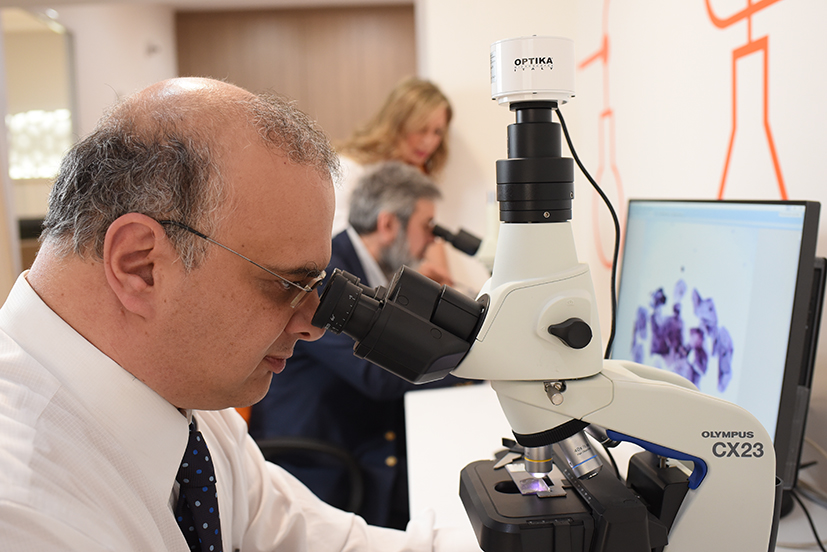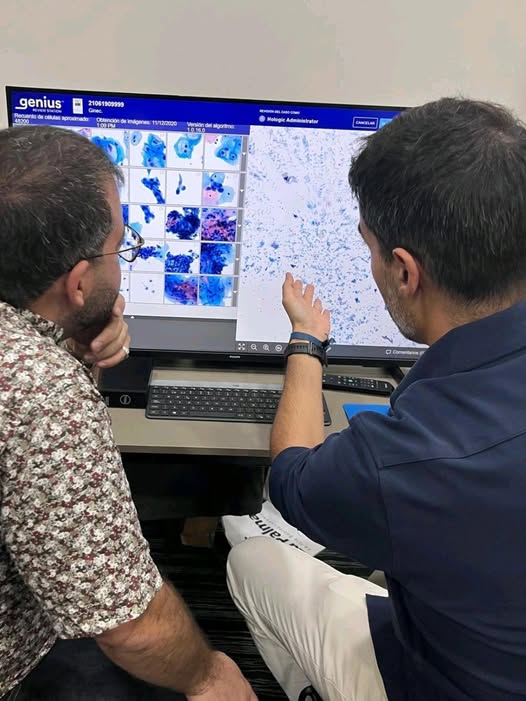Overview
Cytology involves examining cells from bodily tissues or fluids under a microscope to determine a diagnosis. Image used with permission from the U.S. Centers for Disease Control.
What is cytology?
Cytology (also known as cytopathology) involves examining cells from bodily tissues or fluids to determine a diagnosis. A certain kind of physician, called a pathologist, will look at the cells in the tissue sample under a microscope and look for characteristics or abnormalities in the cells. Since cytology only examines cells, which are so tiny, pathologists only need a very small sample of tissue to do a cytology test.
Healthcare providers use cytology in many different areas of medicine, but cytology tests are most commonly used to screen for or diagnose cancer.
What kinds of cytology are there?
There are two main kinds, or branches, of cytology: exfoliative cytology and intervention cytology.
Healthcare providers can use cytology tests for almost all areas of your body. Some common types of cytology tests include:
- Gynecologic cytology.
- Urinary cytology.
- Breast cytology.
- Thyroid cytology.
- Lymph node cytology.
- Respiratory cytology.
- Eye cytology.
- Ear cytology.
What is exfoliative cytology?
Exfoliative cytology is a branch of cytology in which the cells that a pathologist examines are either “shed” by your body naturally or are manually scraped or brushed (exfoliated) from the surface of your tissue.
Examples of exfoliative cytology that involve manual tissue brushing or scraping include:
- Gynecological samples: A Pap smear, which involves brushing off cells from your cervix using a swab, is the most well-known type of exfoliative cytology.
- Gastrointestinal tract samples: Your healthcare provider can brush off cells from the lining of your gastrointestinal tract (your stomach and intestines) during an endoscopy procedure for cytology testing.
- Skin or mucus samples: Your healthcare provider can scrape off cells from your skin or mucous membranes, such as the inside of your nose or mouth, for cytology testing.
Examples of exfoliative cytology that involve collecting tissues or fluids that your body naturally sheds include:
- Respiratory samples: Your provider can collect fluids such as spit and mucus (also called phlegm or sputum) that you cough up for a respiratory cytology test.
- Urinary samples: Your provider can collect a urine (pee) sample from you to use for a cytology test.
- Discharge or secretion samples: If you experience abnormal bodily discharge, such as from your eye, vagina or nipple, your healthcare provider may collect a sample of the discharge for a cytology test.
What is intervention cytology?
Intervention cytology is a branch of cytology in which your healthcare provider has to “intervene” with your body to get a sample of cells to test, meaning they have to pierce your skin in some way to get a sample of cells.
The most common type of intervention cytology is fine-needle aspiration (FNA). A healthcare provider will inject a thin needle into the area that they need to sample and draw out fluid. A pathologist then examines the cells in the fluid under a microscope.
Some areas of your body that a healthcare provider may perform a fine-needle aspiration include:
- Fluid-filled lumps (cysts) under your skin.
- Solid lumps (nodules or masses) under your skin.
- Your lymph nodes.
- Your pericardial fluid, which is the fluid in the sac around your heart.
- Your pleural fluid, which is in the space between your lung and the inside of your chest wall.
When is cytology used?
Healthcare providers and pathologists most commonly use cytology to diagnose or screen for cancer.
A healthcare provider only uses a diagnostic test for a person if they have signs or symptoms that suggest they might have a certain disease or infection. A diagnostic test, such as a cytology test, determines if abnormal cells are present. If so, the test accurately classifies the disease.
A healthcare provider uses screening tests to see if a person could have a certain disease, such as cancer, even before they experience symptoms. A popular type of cytology screening test is a Pap smear.
Other uses for cytology tests include:
- To diagnose infectious diseases.
- To diagnose inflammatory conditions.
- To examine thyroid lesions.
- To diagnose diseases involving certain body cavities, such as the space that’s between two thin membranes that line and surround your lungs (pleural cavity).
Who performs a cytology test?
Depending on the type of cytology test, many types of healthcare providers could collect the sample of cells. For example, a gynecologist may take a sample from your cervix for a Pap smear cytology test. The healthcare provider then sends the sample to a laboratory for testing. A pathologist or cytopathologist looks at the cells from the tissue sample under a microscope and determines a diagnosis, if applicable.
Test Details
How does a cytology test work?
Each cytology test is slightly different depending on what kind of cells are being tested and if the sample is tissue or fluid. In general, there are four steps to a cytology test including:
- Collecting the sample cells.
- Processing the sample cells.
- Examining the sample cells.
- Sharing the results.
Here’s an explanation of the steps of a cytology test.
Collecting the sample cells
Your healthcare provider collects the sample of cells from your body that they need a pathologist to examine. Some of the ways a provider can collect cytology test samples include:
- Brushing or scraping tissue from the surface of a part of your body.
- Collecting fluid or discharge samples from your body, such as a pee sample.
- Using fine-needle aspiration to draw a fluid sample from an area in your body.
Processing the sample cells
For some types of cytology tests that involve tissue samples, the healthcare provider who took the sample smears or spreads it on glass microscope slides. These slides are known as smears. They then send the smears to a pathology laboratory.
If the cytology test involves bodily fluid, the healthcare provider most likely won’t be able to use smears since the sample is too diluted (there are only a few cells in the fluid). They’ll most likely send the sample to a pathology lab in a small container.
Once a cytology sample arrives at the laboratory, a pathologist or lab technician dips the smears in certain stains (colored dyes) depending on what kind of sample it is. The stains help make the cells easier to see and examine under a microscope.
If the cytology sample is a fluid, a pathologist or lab technician may use a machine called a centrifuge to separate the cells they want to examine from the fluid. A centrifuge separates certain cells from fluid by spinning the sample very quickly. The pathologist then puts the cells on smears and may stain them.
Examining the sample cells
After a pathologist or lab technician processes and stains the cytology samples, they examine the cells under a microscope, looking for abnormal cells. If they find abnormal cells, they mark them on the slides with a special pen. A pathologist then makes a diagnosis based on the cells and puts together a report.
Sharing the results
After they put together a report, the pathologist will send it to your healthcare provider. Your provider will go over the results with you and determine the next steps.
How do I prepare for a cytology test?
Most cytology tests are simple and painless, so you don’t have to do anything special to prepare for them. Your healthcare provider will explain the process of your specific cytology test and will let you know if you need to do anything to prepare.
What should I expect after my cytology test?
The healthcare provider who performed your cytology test will send the tissue sample cells to a laboratory where a cytologist or pathologist will examine the cells under a microscope, looking for abnormal cells or certain characteristics. The pathologist will then send a report of the findings to your healthcare provider, who will share the results with you.
What are the risks and disadvantages of cytology tests?
Complications from cytology tests are very rare and if they happen, they’re often mild. Like many types of medical tests, a cytology test can give a false negative or false positive result. Additionally, in some cases, tissue biopsies can be more accurate than cytology tests.
What are the benefits of cytology tests?
Cytology tests have many benefits due to the small amount of tissue or fluid sample that is needed for the test. Compared to a tissue biopsy, which healthcare providers also use to determine a diagnosis, a cytology test:
- Is less invasive.
- Causes less discomfort and pain.
- Is less likely to cause complications.
- Costs less.


